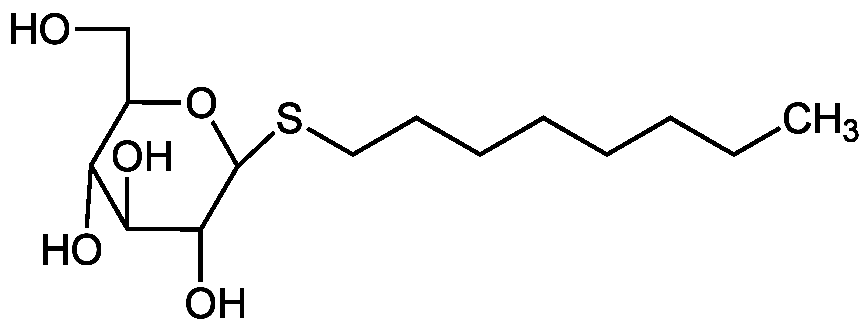
Chemical Structure
n-Octyl-beta-D-thioglucopyranoside (ultrapure) [85618-21-9]

AG-CC1-0005
Overview
- SupplierAdipoGen Life Sciences
- Product Namen-Octyl-beta-D-thioglucopyranoside (ultrapure) [85618-21-9]
- Delivery Days Customer10
- CAS Number85618-21-9
- CertificationResearch Use Only
- Estimated Purity>99%
- Molecular FormulaC14H28O5S
- Molecular Weight308.4
- Scientific DescriptionChemical. CAS: 85618-21-9. Formula: C14H28O5S. MW: 308.4. Non-ionic detergent. For functional solubilization, purification and crystallography of membrane proteins. The thioether linkage makes it resistant to degradation by beta-glucosidase enzymes. For the stabilization and activation of enzymes. Used for cell lysis experiments. - Non-ionic detergent. For functional solubilization, purification and crystallography of membrane proteins. The thioether linkage makes it resistant to degradation by beta-glucosidase enzymes. For the stabilization and activation of enzymes. Used for cell lysis experiments.
- SMILESCCCCCCCCSC1OC(CO)C(O)C(O)C1O
- Storage Instruction-20°C,2°C to 8°C
- UNSPSC12352200
References
- Use of n-octyl-beta-D-thioglucoside, a new nonionic detergent, for solubilization and reconstitution of membrane proteins: T. Tsuchiya & S. Saito; J. Biochem. 96, 1593 (1984)
- Characteristics of n-octyl beta-D-thioglucopyranoside, a new non-ionic detergent useful for membrane biochemistry: S. Saito & T. Tsuchiya; Biochem. J. 222, 829 (1984)
- Use of octyl beta-thioglucopyranoside in two-dimensional crystallization of membrane proteins: M. Chami, et al.; J. Struct. Biol. 133, 64 (2001)
- Surface Activity, Micelle Formation, and Growth of n-Octyl-beta-d-Thioglucopyranoside in Aqueous Solutions at Different Temperatures: J.A. Molina-Bolivar, et al.; J. Phys. Chem. B 108, 12813 (2004)
- Use of n-Octyl-beta-D-thioglucopyranoside in the isolation of a bacterial membrane protein: an improved method for immunological applications.: J.M. Peula-Garcia, et al.; J. Surface Sci. Technol. 22, 141 (2006)
- Development and crystallization of a minimal thermostabilised G protein-coupled receptor: T. Warne, et al.; Protein Expr. Purif. 65, 204 (2009)
- Solubilization and structural stability of bacteriorhodopsin with a mild nonionic detergent, n-Octyl-beta-thioglucoside: A. Asada, & M. Sonoyama; Biosci. Biotechnol. Biochem. 75, 376 (2011)
- Characterization of mixed non-ionic surfactants n-octyl-beta-D-thioglucoside and octaethylene-glycol monododecyl ether: micellization and microstructure: C.C. Ruiz & J.A. Molina-Bolivar; J. Colloid. Interface Sci. 361, 178 (2011)
- Mass spectrometry of intact membrane protein complexes: A. Laganowsky, et al.; Nat. Protocols 8, 639 (2013)
